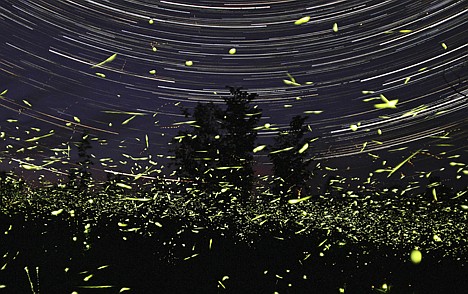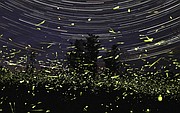Volunteers helping track firefly numbers
INDIANAPOLIS - The yellow-green streaks of fireflies that bring a magical air to summer nights, inspire camp songs and often end up in jars in children's bedrooms may be flickering out in the nation's backyards as suburban sprawl encroaches on their habitats.
Scientists concerned by reports from the public that they are seeing fewer of the luminous insects each summer have turned to a network of backyard volunteers spanning much of the nation to track their range and numbers. Their observations may shed light on whether fireflies are indeed declining - a trend that could dwindle the targets for the childhood rite of passage of chasing fireflies.
As this weekend marks summer's unofficial end in America, the Firefly Watch volunteers' work is winding down now that the insects' annual light show is over in all but southern states.
Helen Mester of South Bend, Ind., is one of about 700 volunteers who entered observations this summer of firefly numbers, the color of their lights and flash patterns into the online database maintained by Firefly Watch, which is sponsored by the Boston Museum of Science.
The 54-year-old retiree has counted fireflies for three years for the program from her living room window or her deck, watching the lights that lead males to females for mating.
She's now adept at identifying a common Midwestern firefly often called the Big Dipper firefly by the upside down "J'' light trail its males make as they flash by. She then watches for their female love interests to reply with two blinks from their perch on shrubs or trees.
"That's the female saying, 'OK, here I am - come over here.' You can see the hook and then a couple of flashes. They're kind of a lime green," Mester said.
About 200 firefly species found east of the Rocky Mountains produce through a complex chemical reaction lights ranging from yellow-green, yellow-amber to a pale blue. Light-producing fireflies aren't found west of the Rockies.
Each of the light-producing beetle species has its own unique signaling pattern to attract mates, some blinking, others flickering with their light never turning off.
Since the online Firefly Watch debuted in May 2008, about 5,100 people from 42 states have entered firefly data they collected in their yards, local parks and meadows, said Paul Fontaine, the Boston museum's vice president of education.
Fontaine said the museum is committed to operating the program and database for at least 10 years to provide a year-to-year snapshot of firefly distribution.
The program, which also has volunteers in Canada, Costa Rica, Ghana and India, asks participants to watch fireflies for at least 10 minutes each week. Scientists at Massachusetts' Fitchburg State University and Tufts University are helping with the project.
The data accumulating in the Firefly Watch database may help determine if fireflies are really declining, and if so where it's happening and what could be causing it, said Christopher K. Cratsley, a Fitchburg biology professor who studies fireflies.
The beetles spend most of their life in rich, moist soils dining on earthworms and other soil-dwellers as larva often called glow worms because their abdomens also flash.
Cratsley said replacing meadows and fields with strip malls and parking lots clearly cuts firefly numbers. And there's evidence that the glare of streetlights that come with urban sprawl may interfere with the courtship of some firefly species by washing out their flashes.
He said pesticides, fertilizers and other chemicals can also kill the creatures that firefly larvae feed on, but the extent of that impact is unclear.
Georgia Southern University firefly researcher Jonathan Copeland believes the survey's main contribution will be helping pin down firefly species' distribution. He said the question of whether firefly numbers are shrinking can only be answered by intensive study of specific locations over decades.
"The main value is if they are occurring and where they're occurring," said Copeland, a professor of biology.
San Antonio resident Denise M. Gregoire, who isn't a Firefly Watch participant, lives in the same home where as a child she chased fireflies with friends. Nearly four decades after her parents moved to the home, the summer nights around it are devoid of fireflies.
Gregoire blames development - apartments, houses, a hospital complex - that replaced the fields that once surrounded her home, and the bright security lights that came with it.
"How are they going to eat, how are they going to survive, if all you've got is concrete?" said Gregoire, 48. "I guess they were decimated, because I don't see them anymore."
But far from development, Firefly Watch observers like Steve Irvine still enjoy dazzling firefly displays.
Irvine, 57, has lived for more than three decades in a rural area of Ontario about 150 miles north of Toronto filled with fields and marshes. It's a feast for firefly lovers.
Summertime visitors can step outside just after dusk and find themselves surrounded by tens of thousands of fireflies, blinking greenish-gold to a flickering orange.
"The fields around here are just alive with sparking light - it's just magic. There's countless thousands of them in the air. It's just amazing," Irvine said.



